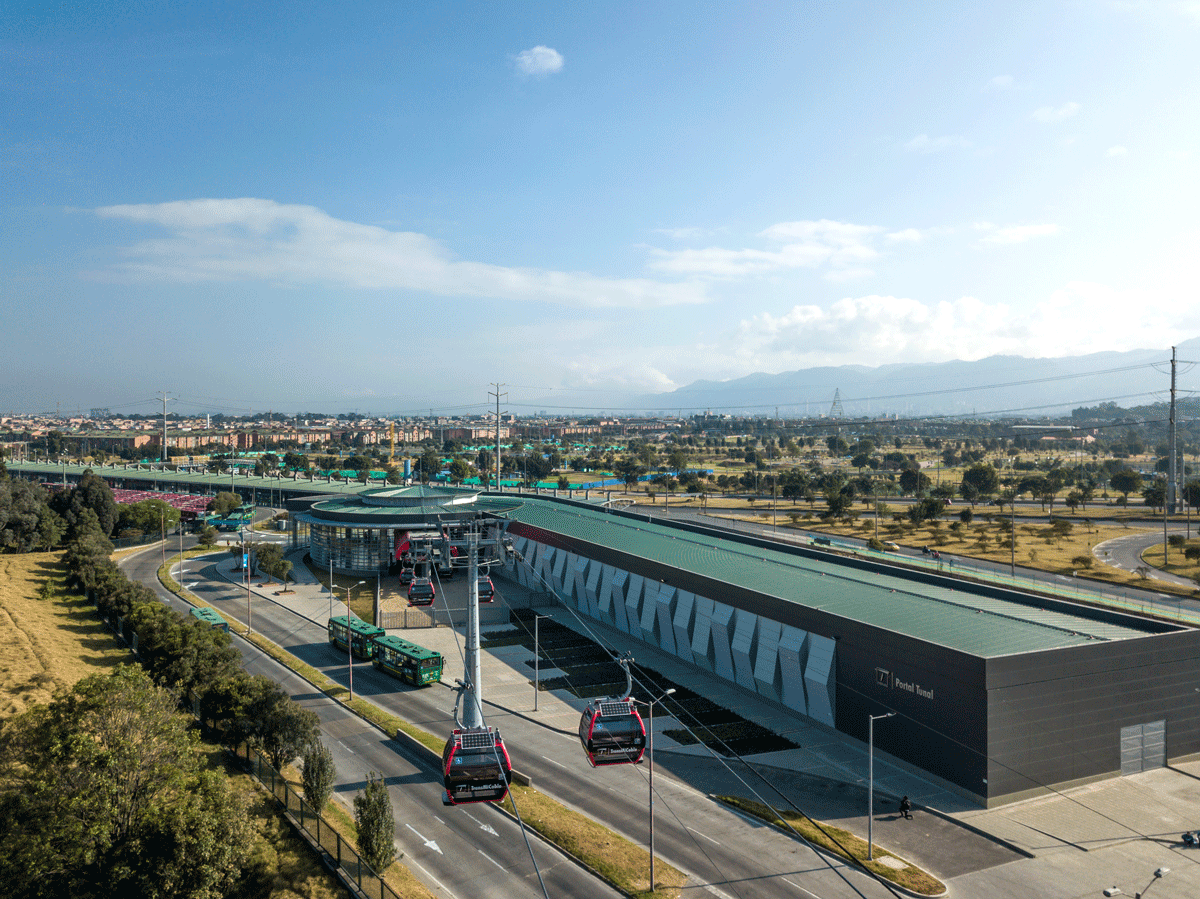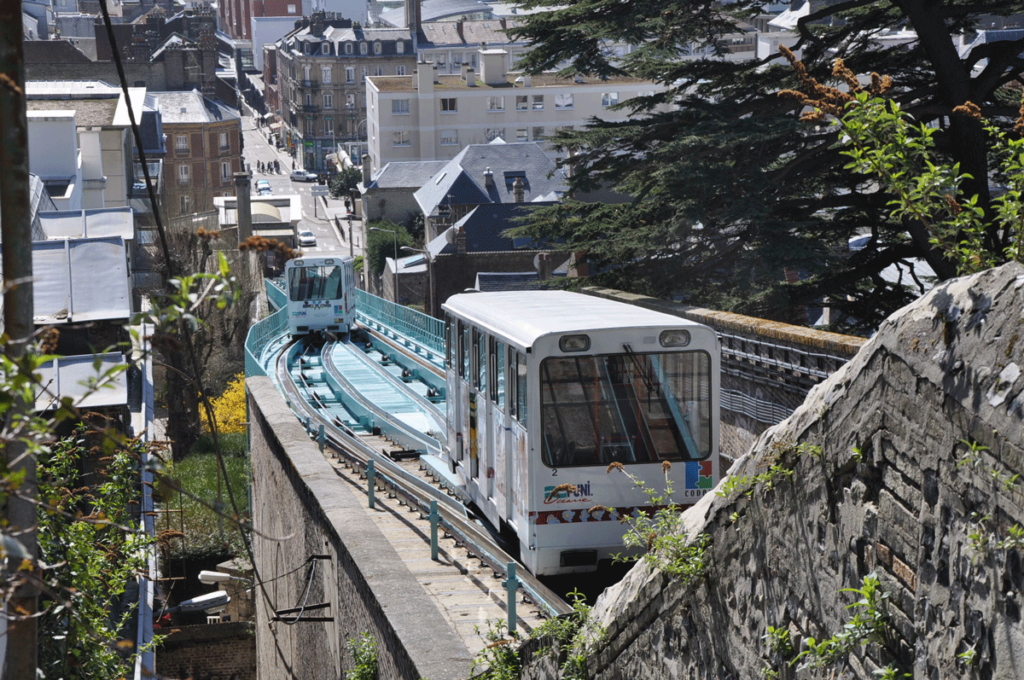
Cities, SI Urban 1/2023
Cable Car as business: Experience with the operation of multimodal mobility
Two megatrends are affecting the business model of mobility service provider TRANSDEV: on the one hand, climate change and the use of resources; on the other hand, rapid urbanisation.
These were highlighted by Christian Kleinenhammann, CEO TRANSDEV Rhein-Ruhr GmbH, in his presentation at conference trade fair Cable Car World.
The funicular railway in the French city of Le Havre
is maintained by TRANSDEV. Photo: Philippe Ale

Climate change & resources
Accordingly, the earth is no longer able to satisfy current consumption of resources. Rising temperatures are causing irreversible ecological changes. “Global economic development must therefore be sustainable or it will cease to exist,” Kleinenhammann is convinced.
Supply and demand for products and services must adapt to the changed realities – that also applies to urban mobility.
Rapid urbanisation
Worldwide, 1.5 million people per week are moving to the cities. By 2050 it is anticipated that 68 percent of the global population will live in cities. Even now, the majority of GDP is generated in urban areas (around 86 percent worldwide in 2019).
“There is therefore a strong demand for us to provide sustainable urban mobility,” Kleinenhammann says. Efficient, multimodal commutes will become the crucial key to success.
Effect on the business model
Both megatrends have a major influence on the business model of TRANSDEV. The company operates 17 different public transport systems in 17 countries – from Metro through dial-a-bus to buses, trains and ferries. 83,000 employees generate turnover of around 7.1 billion euros per year.
Overall, TRANSDEV records around eleven million journeys per day. Some of these are now also made by urban cable cars. TRANSDEV sees the fast commissioning as a particular advantage of the cable car.
According to Kleinenhammann, “it took under three years between construction and initial operation of the Cablemóvil in Bogotá.” Moreover, the cable car is clearly the most environmentally friendly mobility solution, as shown by a life cycle study based on the example of the La Paz cable car.
Cable cars in Bogotá and Le Havre
Specifically, TRANSDEV operates a circulating track in the Colombian city of Bogotá and a funicular railway in the French city of Le Havre.
“In Bogotá 700,000 residents live in the catchment area of the cable car. Four stations connect the higher-altitude districts to the express bus system in the valley,” Kleinenhammann reports.
The commuting time is reduced by around an hour and a half per journey (3.34 kilometres in 13.5 minutes). The cable car transports up to 3,600 passengers per hour – which is equivalent to 18 buses.
“The funicular railway in Le Havre is geared more to tourists and has been in operation since 1890, with several interruptions and modernisations,” Kleinenhammann continues.
The installation connects the city centre with a residential area up the hill; both stations are linked to the bus network. The two vehicles each have 20 seats and standing room for 40 people.
Cooperation models as an opportunity
According to Kleinenhammann, TRANSDEV runs both systems smoothly. There are several reasons for this. For one, the operation of cable cars is tried and tested and the technology requires little maintenance.
“Moreover, there is the prospect of partially automated operation,” the mobility expert says. In addition, interdisciplinary, global teams of experts from the TRANSDEV group regularly discuss projects and market trends. “Our trainingconcepts for the operating staff are variable and regionally independent,
so that our capacity can be adapted quickly,” Kleinenhammann reports. Furthermore, TRANSDEV cooperates with municipal transport companies and operating authorities to pass on knowledge.
There is also close cooperation with manufacturers and suppliers, so that infrastructure, operation and maintenance can be coordinated. “Cooperation models are essential for the operation of urban cable cars,” the mobility expert summarises.
Obstacles
Science and practice demonstrate: urban cable cars are a mode of transport that is environmentally friendly and quick to construct; with the right approach, it can be operated with no problems. Yet why is the integration of urban cable cars so slow?
“I think the transport potential and the application of cable cars are not yet sufficiently recognised,” Kleinenhammann says. Supposed system gaps jeopardise the attraction, even though these are already a reality for example between underground train and bus transport.
Another reason is that the population has concerns over privacy and safety. “Transport company fears over the distribution of resources that have been increasingly scarce in the past must also not be underestimated,” Kleinenhammann emphasises.
Success factors
Nonetheless, there are also ways and means to promote the integration of urban cable cars – such as with detailed analysis of existing movement flows. Moreover, potential improvements should be revealed.
“In the future, for every mobility problem of a city, all the transport providers should be compared as part of a comprehensive economic approach – from bus through Metro to cable car,” Kleinenhammann claims.
Other success factors include consideration of the opportunity costs as well as cable car fare integration, and early, comprehensive involvement and participation of citizens, to improve acceptance.








